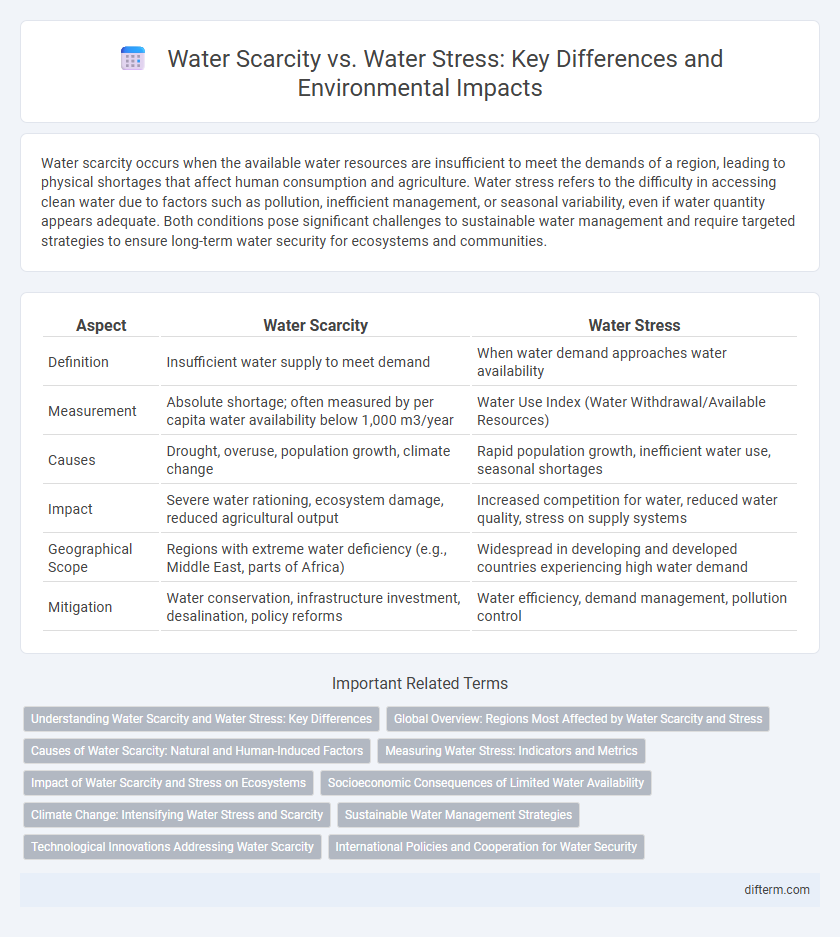Water scarcity occurs when the available water resources are insufficient to meet the demands of a region, leading to physical shortages that affect human consumption and agriculture. Water stress refers to the difficulty in accessing clean water due to factors such as pollution, inefficient management, or seasonal variability, even if water quantity appears adequate. Both conditions pose significant challenges to sustainable water management and require targeted strategies to ensure long-term water security for ecosystems and communities.
Table of Comparison
| Aspect | Water Scarcity | Water Stress |
|---|---|---|
| Definition | Insufficient water supply to meet demand | When water demand approaches water availability |
| Measurement | Absolute shortage; often measured by per capita water availability below 1,000 m3/year | Water Use Index (Water Withdrawal/Available Resources) |
| Causes | Drought, overuse, population growth, climate change | Rapid population growth, inefficient water use, seasonal shortages |
| Impact | Severe water rationing, ecosystem damage, reduced agricultural output | Increased competition for water, reduced water quality, stress on supply systems |
| Geographical Scope | Regions with extreme water deficiency (e.g., Middle East, parts of Africa) | Widespread in developing and developed countries experiencing high water demand |
| Mitigation | Water conservation, infrastructure investment, desalination, policy reforms | Water efficiency, demand management, pollution control |
Understanding Water Scarcity and Water Stress: Key Differences
Water scarcity occurs when the total water available is insufficient to meet the demand of a region, often due to physical lack or poor infrastructure. Water stress refers to the difficulty in accessing adequate quantities of water for use, influenced by factors like over-extraction, pollution, or seasonal variability. Understanding the distinction between water scarcity and water stress is crucial for efficient water resource management and sustainable policy development.
Global Overview: Regions Most Affected by Water Scarcity and Stress
Regions most affected by water scarcity include Northern Africa, the Middle East, and parts of South Asia, where average annual renewable water resources per capita fall below 1,000 cubic meters. Water stress, characterized by lower thresholds of 1,700 cubic meters per capita annually, impacts large areas of Sub-Saharan Africa, Southern Europe, and Central Asia. Climate change exacerbates these conditions, intensifying droughts and reducing freshwater availability across these vulnerable regions.
Causes of Water Scarcity: Natural and Human-Induced Factors
Water scarcity arises from natural factors like droughts, reduced rainfall, and depletion of groundwater reserves, which limit the availability of freshwater resources. Human-induced causes include over-extraction of water for agriculture, industrial use, inefficient water management, pollution, and population growth that increases demand. Climate change exacerbates both natural and anthropogenic pressures, intensifying water stress and leading to severe water scarcity in vulnerable regions.
Measuring Water Stress: Indicators and Metrics
Measuring water stress involves analyzing indicators such as the Falkenmark Water Stress Index, which quantifies per capita water availability below 1,700 cubic meters annually as a critical threshold. Metrics like the Water Exploitation Index (WEI) assess the proportion of total water withdrawals relative to renewable water resources, highlighting regions facing unsustainable demand. These indicators enable policymakers to differentiate between water scarcity--absolute water shortage--and water stress, which reflects the difficulties in water management under limited supply conditions.
Impact of Water Scarcity and Stress on Ecosystems
Water scarcity disrupts aquatic and terrestrial ecosystems by reducing freshwater availability, leading to habitat degradation and loss of biodiversity. Water stress alters hydrological cycles, affecting species survival, soil quality, and vegetation health. These pressures compromise ecosystem services, including water purification, climate regulation, and nutrient cycling essential for ecological balance.
Socioeconomic Consequences of Limited Water Availability
Water scarcity, characterized by an absolute lack of sufficient water resources, leads to severe socioeconomic consequences including impaired agricultural productivity, heightened food insecurity, and increased health risks in vulnerable communities. Water stress, a condition where demand exceeds supply during certain periods, exacerbates economic disparities by limiting industrial growth and elevating the cost of clean water access, disproportionately affecting low-income populations. Limited water availability disrupts livelihoods, reduces educational opportunities, and triggers migration, intensifying poverty cycles and undermining sustainable development goals.
Climate Change: Intensifying Water Stress and Scarcity
Climate change significantly intensifies water stress and scarcity by altering precipitation patterns and accelerating evaporation rates, leading to unpredictable water availability. Regions already vulnerable to water scarcity face exacerbated challenges due to prolonged droughts and reduced freshwater reserves. Effective adaptation strategies must incorporate climate models to manage water resources sustainably and mitigate the impacts on agriculture, ecosystems, and human populations.
Sustainable Water Management Strategies
Sustainable water management strategies address both water scarcity and water stress by optimizing water use efficiency and promoting conservation practices. Implementing integrated water resource management (IWRM) enhances groundwater recharge, reduces pollution, and ensures equitable distribution among agricultural, industrial, and domestic sectors. Employing technologies like rainwater harvesting, wastewater recycling, and smart irrigation systems supports resilience against climate change impacts and growing demand.
Technological Innovations Addressing Water Scarcity
Technological innovations such as advanced desalination, smart irrigation systems, and AI-driven water management platforms are critical in mitigating water scarcity by enhancing efficient water use and expanding accessible freshwater sources. Satellite monitoring combined with IoT sensors enables real-time data analysis to optimize water distribution and reduce wastage in agriculture and urban areas experiencing severe water stress. Emerging technologies like drought-resistant crops and atmospheric water harvesting contribute to sustainable solutions addressing both acute scarcity and chronic water stress challenges worldwide.
International Policies and Cooperation for Water Security
International policies and cooperation play a crucial role in addressing water scarcity and water stress by promoting sustainable water management and equitable resource distribution across borders. Agreements such as the UN Watercourses Convention and regional frameworks like the Nile Basin Initiative facilitate data sharing, conflict resolution, and joint infrastructure projects to enhance water security. Multilateral collaboration helps mitigate the impacts of climate change and population growth on freshwater availability, ensuring long-term resilience for affected communities.
water scarcity vs water stress Infographic

 difterm.com
difterm.com